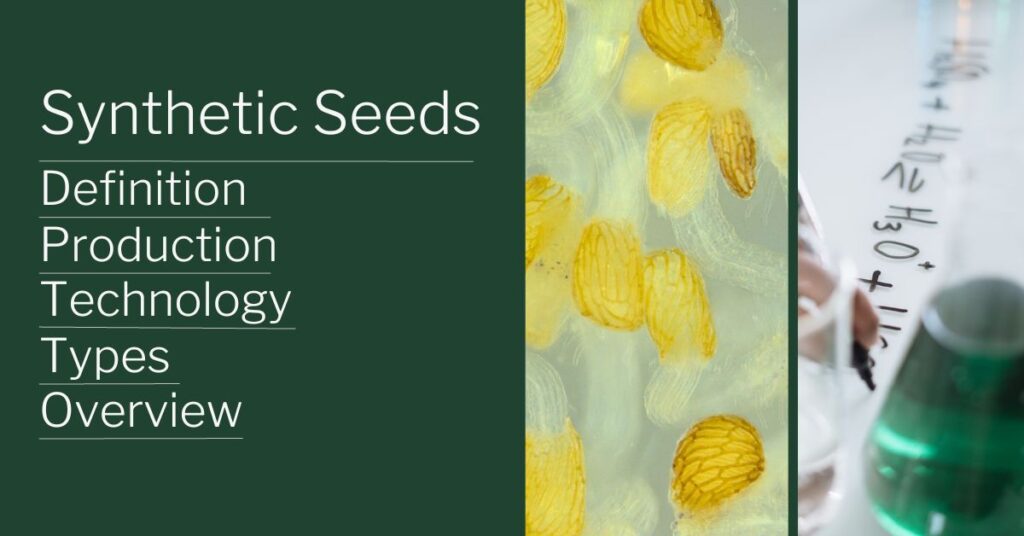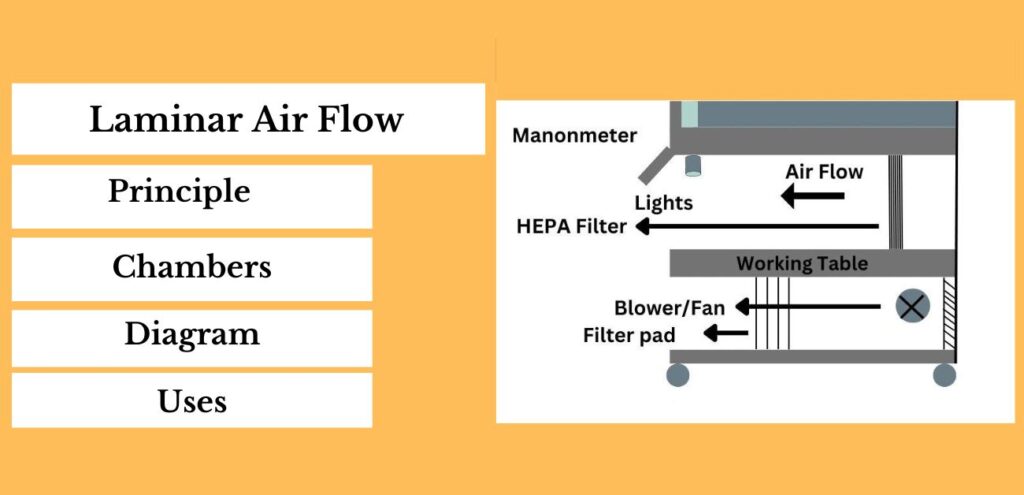A seed is what grows into a whole new plant and can be called a fundamental unit of plant right. But sometimes environmental and agricultural conditions are not suitable enough for a natural seed to grow properly. Well interestingly, this is where synthetic seed comes into play.
Now the question is that what are actually these seeds? Simply speaking synthetic seeds are artificial seeds that are created by artificially encapsulating somatic embryos, tissues, cell aggregates or shoot buds within a protective coating.
To clear all of your doubts about these artificial seeds, let’s look forward to this article as we will discuss what these seeds are, their types, how they are produced, the technology involved, and applications.
What Is Synthetic Seed
The purpose of synthetic seeds is to mimic the functions of natural seeds, it allows the preservation, storage, and propagation of plant’s genetic material and promotes its growth into mature plants under controlled conditions.
As mentioned above an artificial seed is formed by encapsulating parts such as embryos, shoot buds, plant cell, or cell aggregates which have the ability to grow into a plant. This encapsulation also includes nutrients and growth-promoting substances in them for the proper growth of a plant.
Let’s take a look at the technology with which these artificial seeds came into existence.
Synthetic Seed Technology
Synthetic Seed Technology is a biotechnology technique which has developed over several decades through a series of scientific advancements and research. Plant tissue culture especially plays an important role in this technology.
Dr. Toshio Murashige, a plant physiologist, contributed significantly to synthetic seed technology. He was the first to propose the idea of artificial seeds and made great contributions to tissue culture methods which turned out to be really important for these seeds and their production.
There are various plant tissue culture methods for such seeds, out of which Somatic Embryogenesis is the most famous one. In Somatic Embryogenesis, somatic embryos or other plant cells are encapsulated within a matrix or gel to create synthetic seeds with the proper nutrients within.
Some other plant tissue culture methods are –
- Shoot and Root Culture – instead of embryos, shoots or roots are encapsulated and used to cultivate plants in artificial seed form.
- Callus Culture – Callus is an undifferentiated mass of cells that can be induced from various plant tissues. It starts the propagation in plant materials for somatic embryogenesis or can be used directly for synthetic seed production.
- Suspension Culture – In this plant tissue culture method, plant cell or small tissue fragments are grown in a liquid medium with constant agitation.
- Meristem Culture – Meristem tissues are isolated and cultured to obtain virus-free plant material, which can then be used to produce artificial seeds.
- Genetic Modification – Genes of interest are propagated in plant tissues, and these genetically modified tissues can then be used to produce seeds with desired traits.
Now that we’ve learned about the technology, let’s dive into how these seeds were produced and their preparation steps.
Synthetic Seed Production
Synthetic seed is produced by encapsulating somatic embryo with Calcium Alginate gel. This gel is enriched with nutrients which are needed for the growing plant.

There are many steps involved in the artificial seed preparation. Let’s look at its production procedure.
Synthetic seed production procedure
There are different steps taken in the preparation of these seeds. Here’s a step-by-step synthetic seed preparation protocol –
Selection Of Parent Plant Material
Selecting suitable plant material like somatic embryos, shoot tips, meristems, plant cell or other plant tissues for the production.
In Vitro Culture
After selecting the parent material it is placed in a laboratory environment also known as In vitro culture, such as a tissue culture medium.
Application Of Tissue Culture Techniques
Plant tissue culture techniques are then used to introduce the embryo in the callus for the synthetic seed formation.
Embryo or Tissue Proliferation
Embryo proliferation allows the plant material to multiply and propagate to form multiple embryos or tissue masses.
Histodifferentiation
Histodifferentiation is an important step in the synthetic seed production procedure. In this phase the somatic embryos or the plant tissues undergo a series of developmental changes like that of a natural seed which include the differentiation of various types of plant cell and tissues.
Desiccation (Drying)
After Histodifferentiation, the somatic embryos go through a controlled drying process known as desiccation. This is an important step in the synthetic seed production procedure. In Desiccation the moisture content within the embryos and the surrounding matrix is reduced which make them durable for transportation.
Encapsulation
The plant material is then encapsulated in a protective matrix or coating containing nutrients, growth regulators, and sometimes, protective chemicals where they are grown.
Formation of Synthetic Seeds
The encapsulated somatic embryos are then shaped into seed-like structures as described in earlier steps, creating artificial seeds.
Storage And Germination
The formed seeds are then stored at low temperature for months and even years in a controlled environment to maintain their viability. When suitable conditions are provided these artificial seeds are sown in a growth medium to initiate germination whenever required and the somatic embryos within them grow into plants.
After looking at the production procedure below are the types of synthetic seeds that are produced.
Synthetic Seed Types
There are basically two types of synthetic aka artificial seeds –
Desiccated Synthetic Seeds
- Multiple somatic embryos are encapsulated followed by desiccation, which result in reduced moisture content within the seed-like structure.
- Polyoxyethylene, also known as Polyox, is used as the encapsulating material. It is a non-toxic material which doesn’t allow any growth of microorganisms.
- These seeds are typically in a dormant state, with slowed metabolic activity due to low moisture content.
- They are capable of prolonged storage and can be stored under controlled conditions until the seeds are ready for use.
Hydrated Synthetic Seeds
- A single somatic embryo is enclosed in hydrogel capsules. Hydrogels such as potassium alginate, calcium alginate, or sodium pectate are used.
- These seeds, on the other hand, are sensitive to desiccation and are exposed to moisture instead for their metabolic processes and germination.
- They are typically used for sowing, where they germinate and grow into mature plants when provided with appropriate environmental conditions, such as light, temperature, and nutrients.
Synthetic Seed Diagram

Applications
The introduction of artificial seeds has made a lot of things feasible in terms of plant production. Irrespective of the environmental conditions and scenarios these seeds give fruitful results without a worry and have various applications.
Here are some of the applications of synthetic seeds –
Clonal Propagation
These seeds are used to grow plants with genetic uniformity through clonal propagation, which ensures that the offspring are genetically identical to the parent plant.
Rapid Multiplication
They provide a means to rapidly and efficiently propagate plant cells, allowing for the production of a large number of uniform plants from a small quantity of plant material.
Genetic Modification
Synthetic seed technology is used for genetic modification and improvement of plant varieties. Genetically modified somatic embryos or plant tissue can be encapsulated to produce varieties of crops and grow plants with desired traits.
Disease-Free Propagation
Since they are produced from in vitro cultures, which are typically free from pathogens and diseases, it ensures disease-free propagation and production of planting material.
Germplasm Preservation
Germplasm preservation in synthetic seeds is an important application of this technology. These seeds can be used to preserve and store the germplasm of valuable, rare, or endangered plant species to protect genetic diversity.
Customized Encapsulation
Encapsulation techniques can be customized to grow different plant species through synthetic seeds. Some encapsulations instead of gel have biodegradable polymers, seed pellets, multi-layers, etc.
Crop Conservation
Synthetic seeds are also used to conserve and multiply valuable crop varieties, heirloom plants, and indigenous species.
Commercial Production
In some cases, these artificial seeds are produced and distributed commercially for farmers offering a convenient and efficient way to access planting material.
There are a lot of applications of synthetic seeds as seen above, now along with their applications comes the advantages and disadvantages as well. Have a look.
Advantages
- Have both short-term and long-term storage capacity.
- Planting materials for synthetic seeds are very cost efficient.
- Customization for different plant species.
- Breeding programs are more feasible.
- Biodiversity conservation – preserving and propagating endangered or rare plant species.
- Reduction of post-harvest losses.
- Efficient high-value crop propagation.
- The principle of synthetic seed preparation aims to combine the advantages of plant tissue culture techniques with those of traditional seeds.
- Biotechnology research applications.
- Restoration of ecosystems.
- Preservation of traditional crops.
- More cost-efficient as compared to traditional seeds.
- They have cost-effective propagation methods.
- Different plants such as medicinal, cereal plants can be studied anywhere with the help of synthetic seeds.
- They are easy to handle and transport as they are small.
- They can be used right away to grow plants and crops in fields.
Disadvantages
- The synthetic seed technology is not equally successful for all plant species, and can be limited to certain crops.
- They have shorter storage life spans compared to traditional seeds, and their long-term viability can be a concern.
- They are dependent on laboratory facilities like plant tissue culture and skilled technicians, which creates problems for small-scale farmers.
- Somatic embryo maturation is generally inefficient in synthetic seed formation, which results in poor plant germination, growth, and development.
- Due to the decreased survival rate of somatic embryos in many plant species, the utility of artificial seed is restricted.
- Some somatic embryos are not capable of coming out of the encapsulation material.
Conclusion
Synthetic seed technology is a remarkable fusion of biotechnology and agriculture, offering solutions to challenges in crop propagation, genetic preservation, and conservation. These artificial seeds offer a promising means of effectively propagating desirable plant species in the changing environment conditions. The synthetic seed production procedure is a carefully organized series of steps that merges cutting-edge science with the fundamental principles of botany.
Also Read :





